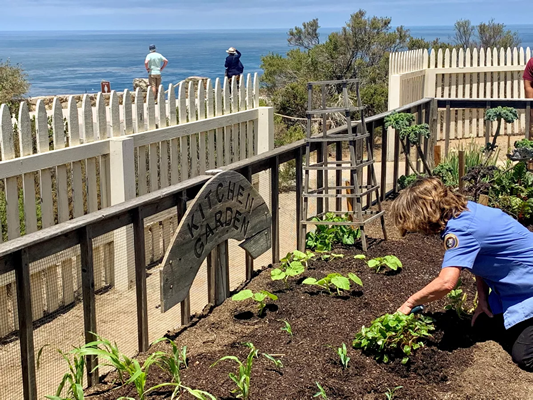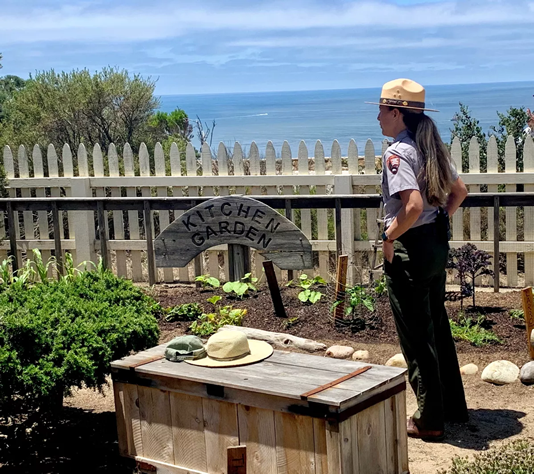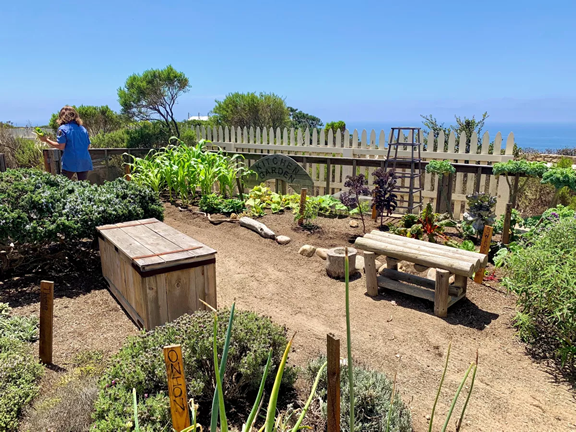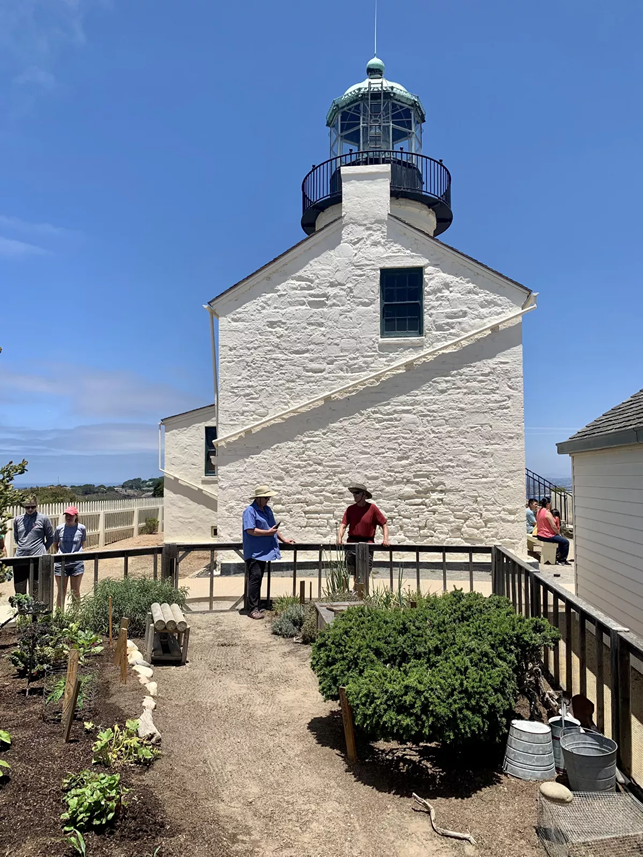Harvest some enjoyment with your own kitchen garden

A replica 19th-century kitchen garden outside the iconic Point Loma Lighthouse can provide local inspiration. The garden plot, funded by the Point Loma Garden Club, is maintained by park volunteers at Cabrillo National Monument.(Helen Purcell Montag)
BY HELEN PURCELL MONTAG
(This article originally appeared in the September 10, 2022 issue of the San Diego Union-Tribune)
No doubt about it: Gardening can promote a sustainable, healthy and active lifestyle. You’ll enjoy the outdoors as you get your hands in the soil planting seeds, vegetables, fruits or flowers. You’ll reap benefits from all your efforts as you watch plants grow, and you’ll relish making social connections to share your accomplishments or ask for advice. Join me as I encourage you to discover or continue to enjoy the age-old tranquility, pleasures and rewards of gardening.
If you think you don’t have enough time or space to garden, are not sure where to begin or believe you lack the knowledge and skills to create and maintain a garden, think again. I have a special garden in mind for you … a garden that doesn’t require any special training, doesn’t require a great deal of tending, and is used in many ways. This is a garden you’ll design, plant and comfortably maintain with minimal effort.
Always known for enjoying a taste of the good life, the French call this type of garden a potager. We call it a “kitchen garden.” You’ll find it located outside the house and near — you guessed it — the kitchen!
Small or spacious, kitchen gardens are planted in the ground, in raised beds, or on patios and windowsills using smaller containers. Unlike other gardens, a kitchen garden is specifically meant to provide produce to be used in the home. Creating a kitchen garden is possible for anyone. Master Gardeners have resources and tips to help you succeed — from start to finish.

In 1913, President Woodrow Wilson signed a proclamation setting aside land surrounding the Point Loma Lighthouse to commemorate the 1542 discovery of the California coast by Juan Rodriguez Cabrillo. Twenty years later, the lighthouse became a part of the U.S. National Park Service’s Cabrillo National Monument, one of the most visited national monuments in the country.(Helen Purcell Montag)
Most kitchen gardens are informal, with fruit, vegetable and herb plantings that are easily grown from seed or available as starts. A sunny spot works best. You may wish to include vegetables such as lettuce, cucumbers, radishes or leeks. Add your favorite aromatic herbs such as basil or parsley; include a tomato plant and a strawberry plant or two, and, voila! You’ve created your personal kitchen garden. In a few months, you’ll be stepping outside to take a snip or grab a bunch of greens, using whatever you’ve planted to add to the day’s meal, cooking it up fresh in your kitchen.
As for tending your kitchen garden, pay attention to what’s starting to grow, about to sprout, or ready for harvesting. Throughout the year, you can plant seasonal seeds or seedlings that will bring homegrown edibles into your kitchen.
Visiting a kitchen garden may be just the outing that inspires you to start one of your own. In San Diego, there is a replica of a 19th-century kitchen garden representing a time when there was no refrigeration, road systems were poor, and traveling to obtain fresh produce was difficult. This kitchen garden, with vegetables and herbs used to supplement a family’s food supply, is in Cabrillo National Monument.
High on a bluff at the tip of the Point Loma peninsula, 422 feet above sea level, the Point Loma Lighthouse became operational in 1855. The light from its Fresnel lens guided mariners and ships to the entrance of San Diego Bay for 36 years. The location seemed ideal at first but turned out to be impractical. While the light from the lighthouse tower was visible to ships and mariners on clear nights, it was often obscured by the dense, low-lying fog that blankets San Diego coastal areas.

The U.S. Park Service has carefully restored the original 1855 Point Loma Lighthouse building to 1880 standards, preserving the interior as a museum for visitors to enjoy and learn about its history. The lighthouse was home to Captain Robert Decatur Israel and his family for almost 20 years.(Helen Purcell Montag)
Decades later, in 1913, President Woodrow Wilson signed a proclamation setting aside land surrounding the lighthouse to commemorate the 1542 discovery of the California coast by Juan Rodriguez Cabrillo. Twenty years later, the Point Loma lighthouse became a part of the U.S. National Park Service’s Cabrillo National Monument, one of the most visited national monuments in the country.
A must-see is the Cabrillo’s Visitor Center complex, with its panoramic views of San Diego’s city skyline and bay, the Pacific Ocean, and Coronado Islands, off the coast of Baja, California. A winding paved path will take you up to the highest point in the park, where you’ll find one of the earliest lighthouses built along the Pacific Coast. At every turn, you’ll find even more spectacular views.
The U.S. Park Service has carefully restored the original 1855 Point Loma Lighthouse building to 1880 standards, preserving the interior as a museum for visitors to enjoy and learn about its history. The lighthouse was home to Captain Robert Decatur Israel and his family for 20 years.

Outside and adjacent to the Point Loma Lighthouse there is a replica of a 19th-century kitchen garden. The Israel’s family kitchen garden had root vegetables, leafy greens and fruit, which were essential to supplement the family’s food supply.(Helen Purcell Montag)
Be sure to visit the inspiring replica of the Point Loma Lighthouse “kitchen garden.” Back in the 1880s, it was a two-hour horse-and-buggy ride up and down the hill into Old Town to obtain food provisions and water, and to visit family and friends. Kitchen gardens were often a necessity rather than a choice. The Israels’ family kitchen garden had root vegetables, leafy greens and fruit, which were essential to supplement the family’s food supply. Today, this replica kitchen garden, funded by the Point Loma Garden Club, is maintained by Cabrillo Monument Park volunteers.
Kitchen gardens are a wonderful option, whether you’re new to gardening or consider yourself an avid gardening enthusiast. No matter where you live or what space you have available, the Master Gardener Association of San Diego County website has resources to assist you with plant selections and soil and water requirements. One of my favorite gardening quotes from English poet Alfred Austin is “Show me your garden…and I will tell you what you are like.”
Well, show me your kitchen garden, and I’ll tell you what you enjoy cooking and eating!

The lighthouse’s kitchen garden, funded by the Point Loma Garden Club, offers a real-life look at the types of foods the family living there would have relied upon.(Helen Purcell Montag)
Helen Purcell Montag is an active UC Master Gardener who also enjoys history, travel, writing, genealogy and speaking Spanish.

